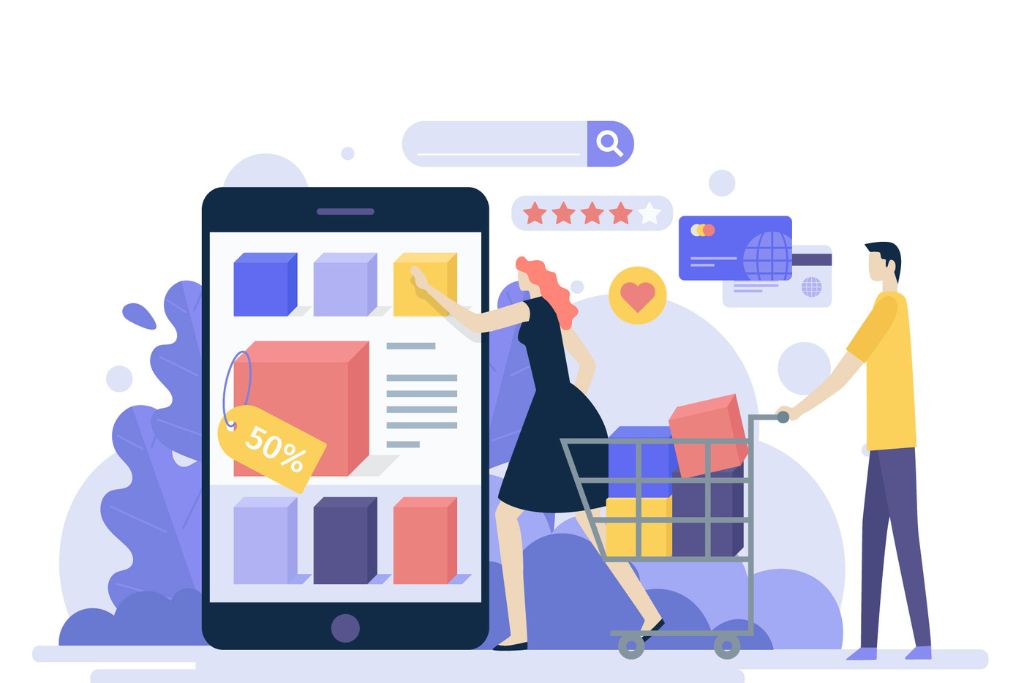Providing excellent customer support is crucial for any business-to-consumer (B2C) ecommerce company. With growing competition in online shopping, having robust support systems in place is key to retaining customers and gaining their loyalty. According to research, about 86% of customers feel more positive about a brand after a great support experience, while nearly 60% would consider switching after a bad one. [1]
Support shouldn’t be viewed as a necessary evil either – it’s actually a big opportunity. Companies that invest in superior support reap multiple benefits like increased sales through repeat purchases and referrals, higher customer satisfaction scores, and lower costs from reduced returns and refunds.
This article will explore the various support systems that B2C ecommerce companies can implement to substantially improve the customer experience. By having comprehensive yet easy-to-use support options available, companies can build trust, foster customer relationships, and gain a competitive edge in today’s demanding digital marketplace.
1. Live Chat
Live chat is a popular way for online shoppers to quickly get answers to questions while browsing a website. It provides a more personal experience than other self-service options by allowing real-time communication. Customers appreciate live chat because it reduces frustrations from long response times associated with other support channels.
To get started with live chat, a company needs to integrate an easy-to-use widget on their website. Popular chat plugins include LivePerson, Tidio, and Drift. The widget should be prominently displayed on high-traffic pages like the homepage, cart, and checkout. Live chat works best when agents are available during peak shopping hours on weekdays as well as weekends.
Having the right staffing in place is important for live chat. Companies should train agents to be friendly, patient, and solution-oriented. Standard greetings, closing messages, and responses to common questions should be developed to ensure consistency. Agents may need coaching on multi-tasking, time management, and prioritizing new chat requests over idle ongoing ones. Periodic chat reviews can provide feedback on agent performance and areas needing improvement.
2. Knowledge Base/FAQs
While live chat is ideal when customers need an immediate response, many questions can also be addressed through a robust knowledge base (KB). A KB is a searchable database of common customer issues and their resolutions. It allows shoppers to find answers on their own schedule through articles, guides and FAQs.
To optimize the KB, companies should identify frequent queries customers have across all support channels. Then detailed articles can be written to cover those topics with step-by-step instructions. Using headings, bold text, and clear language makes articles easy to scan and understand at a glance. Images and videos also help convey processes more effectively.
The KB should be accessible on its own dedicated support page as well as integrated with other tools like the site search bar and live chat pop-up windows. This ensures self-service options are front and center. It’s important to keep KB content fresh by regularly auditing topics, adding new articles, and updating outdated ones. Customers will come to rely on the KB as a trustworthy go-to resource. Checkout: https://zipprr.com/aliexpress-clone/
3. Email Support
While phone and live chat support may not always be practical, email is a ubiquitous way for customers to reach out. Having a dedicated email address clearly listed on the website allows shoppers to submit questions or concerns at their convenience.
To manage high email volumes smoothly, companies need the right systems. Integrating customer support software is helpful for routing emails to agents, tracking message status, and communicating with customers across channels. Agents should have tools to archive conversations, check a shopper’s order and account history, and document resolutions for future reference.
Setting service level agreements (SLAs) ensures shoppers receive timely responses. Benchmarks like replying to general emails within one business day and addressing order status queries within hours help manage expectations. If delays are anticipated, automated out-of-office messages keep customers informed. Emails unreplied beyond the SLA should trigger alerts to management for corrective action.
Proper training also helps improve email response quality. Agents need to communicate empathy, ask clarifying questions respectfully, and provide full yet concise resolutions in their written replies. Checking email signatures and formatting prevents inconsistencies across the team as well. Periodic audits ensure emails are handled professionally and issues are addressed satisfactorily.
4. Phone Support
While most customers prefer self-service options like live chat, searchable knowledge bases, and email support – phone calls remain important for complex issues requiring personal attention. Phone support is valuable for addressing sensitive account issues, resolving billing problems, or dealing with upset customers.
There are two main options for handling calls – outsourcing to a third-party call center or maintaining an in-house team. Outsourcing allows leveraging professional support agents trained specifically for a company’s product or service. However, the customer experience may suffer from lack of contextual insights. In-house teams offer more seamless multi-channel communication but require recruitment, facilities, and ongoing training costs.
Regardless of the setup, best practices like the below optimize phone support:
- User-friendly phone tree and virtual hold music to prevent abandonment
- Performance tracking to handle 80-90% of calls within service level commitments
- Recording select calls to monitor quality and coach agents
- Cross-training agents on knowledge base for consistent resolution quality
- Monitoring average handle time and first contact resolution rates
- Offering call-back options via interactive voice response for convenience
Ongoing quality assurance ensures phonesupport meets or exceeds expectations every time. Satisfaction surveys also provide feedback for continuous enhancement.
5. Self-Service Portal
Beyond static knowledge bases, more advanced self-help features keep customers engaged while empowering them. A personalized customer support portal allows signed-in users to conveniently check order status, view past purchases, track shipment deliveries, submit support tickets, read guides, and get assistance without agent interaction.
Setting up a portal involves developing the following key features:
- Secure login with single sign-on to the main website
- Customizable dashboard view with upcoming/incomplete tasks
- Order lookup tool to find past transactions
- Digital order confirmations and receipts archive
- Integrated return merchandise authorization (RMA) portal
- Status update subscriptions for upcoming/delayed deliveries
- Tutorial videos, manuals and help documents
- Comment/rating widgets to capture feedback
- Seamless navigation to social support and live chat
Personalized UX and proactive communications motivate continued self-service portal usage. Detailed tracking reports also indicate feature effectiveness for further enhancement.
6. Return and Refund Policy
Clear return and refund policies build trust by managing customer expectations upfront. This increases conversion by reducing anxiety around “what if I need to return?”. Comprehensive display of policies also avoids support contact purely to understand timelines and processes.
Key elements of an optimized policy include:
- Standard return window of 14-30 days from delivery date
- Pre-paid return shipping with emailed return labels for convenience
- Refund processing timelines within 2-4 business days of receipt
- Product condition policy for untouched, unwrapped items only
- Restrictions for customized, non-resalable items
- Details of partial refunds for used products
- International and expedited delivery orders terms
- Prominent policy access from cart, order confirmations
- Policy FAQs to address common scenarios
Consistent staff training ensures the policy spirit is honored through every interaction. Automated tools track returns from approval to refund to monitor SLA adherence and check for delays. Periodic policy reviews factor market practices and customer feedback.
7. Shipping and Delivery Updates
Getting products into customers’ hands promptly and keeping them informed along the way is paramount. Building advanced fulfillment processes alone is not enough – transparency also matters. Shoppers appreciate honest, proactive communications regarding order statuses and potential delays.
Having the right shipping partners integrated facilitates seamless shipment tracking visibility. Custom emails should auto-generate at milestone stages like order preparation, carrier handoff, delivery attempts, and completion. Social proof from other users helps set expectations for transit times.
Additional features prove especially valuable for scenarios outside the norm:
- Delay alerts with resolution assistance like alternative items
- Expedited upgrade quotes for impatient customers
- Straightforward reshipment claims for lost/damaged packages
- Email notifications for customs clearance on international orders
- Option to redirect deliveries to alternate addresses
- Integrated returns portal for quick reverse logistics
Collecting fulfillment and transit metrics lets refine processes over time based on operational bottlenecks or carrier performance dips. Ultimately, proactive communication ensures accountability and builds understanding during irregular events outside control.
8. Contact Methods
While phone, email, chat and self-service tools address varied customer needs – having options breeds flexibility. Omnichannel support aims to guide users to the fastest resolution method depending on their circumstances and issue complexity.
Presenting all available channels upfront builds awareness and trust that help is always accessible. Popular contact methods to consider include:
- Live chat and co-browsing embedded on high-traffic pages
- Dedicated toll-free numbers for seamless phone transfers
- Support contact forms and customizable templates
- Social media direct messaging on platforms like Facebook, Twitter
- Option to schedule call-backs or virtual appointments
- Integrated messaging/chat extensions on mobile apps
- Community forums moderated by employees
Integrated greeting communications and agent soft-transfer abilities uphold a seamless omnichannel experience. For example, live chat agents can easily transfer a shopper to the most relevant representative based on their issue. Similarly, phone agents should have tools to quickly search the knowledge base or chat with the customer while on hold.
Signposting between support channels avoids redundant explorations and time wastage. Customers appreciate how solutions can be obtained via their preferred methods. Channel performance analytics also helps resource allocation based on usage patterns. Ultimately, a variety of well-connected contact points ensure simple, swift assistance anytime, anywhere.
9. Ticketing System
To systematically manage incoming customer inquiries, a support ticketing system is indispensable. Tickets represent individual cases that may involve email correspondence, order records, agent notes, and a resolution timeline.
Setting up a competently designed ticketing workflow involves:
- Intuitive web interface and mobile apps for logging new issues
- Templates for common request types, customizable fields
- Ticket assignment, priority setting and SLA configuration
- Standard ticket statuses – open, in progress, on hold, resolved
- Integrations with knowledge base and support portal
- Customizable requester and agent notifications
- Reporting and analytics for business intelligence
Ticketing best practices include default assignment rules to route tickets appropriately. For example, orders queries go directly to an order specialist. Performance metrics such as first response times keep agents accountable while coaching improves resolution quality. Periodic auditing checks for untimely closures or repeating issues.
Comprehensive ticket tracking from inquiry to closure establishes a single source of truth for any customer communication. It brings structure needed to measure, analyze, and refine support operations over long run.
10. Customer Support Reviews
While delivering seamless experiences is the ultimate priority – customers still feel empowered sharing both praise and feedback publicly. Support review ratings and testimonials on sites like Trustpilot indicate brand perceptions and room for enhancement. It’s important for companies address poor reviews transparently to regain trust.
To encourage reviews, companies may:
- Request ratings at the end of ticket resolution, call summaries
- Incentivize reviews with discount codes for future orders
- Respond to negative reviews with corrective actions
- Highlight positive reviews on marketing pages
- Survey resolution pathways for additional qualitative feedback
- Address recurring problems pointed by reviews proactively
- Include reviews snapshot on company profiles
- Allow public responses while preventing unprofessional banter
Review analysis reveals pain points invisible otherwise and helps refine processes, scripts, and training accordingly. Even generic responses show accountability for continuous improvements sought based on user experiences. An open feedback culture fosters relationships built on transparency and trust.
11. Training and Quality Assurance
Frontline agents undeniably impact customers the most. Thus, agent enablement deserves significant attention and investment. Periodic comprehensive training keeps skills sharp and morale high. Topics may include product information, support best practices, soft skills, compliance, and using new tools.
Role plays and simulations mimic real scenarios for building confidence. Assessing training effectiveness identifies knowledge gaps for remediation. Cross-training broadens capabilities to address diverse issues. Refresher courses maintain proficiency on changing policies, procedures or systems.
Quality is best guaranteed through multichannel interaction monitoring and evaluation. Recording calls and chat sessions then reviewing a percentage identifies exemplary and deficient performances for rewards or retraining. Mystery shopping tests convenience of self-service options. Evaluations coupled with observation, coaching and feedback drives continuous enhancement.
Benchmarks like first contact resolution, customer satisfaction ratings and adherence to SLAs assess overall support quality. Round table discussions solicit frontline insights for triaging operational snags. Investing in supporting support staff ultimately translates to memorable brand experiences attracting lifetime customer loyalty.
Conclusion
Implementing comprehensive, nimble support requires coordination across departments and tireless optimization. However, the returns far outweigh the costs in customer retention, repeat purchases and positive word-of-mouth.
This article outlined key support systems that B2C ecommerce companies must consider like live chat, robust self-help resources, transparent order status communications and an integrated ticketing workflow. It also explored best practices around agent training, performance management and quality initiatives.
While a massive upfront investment may not yield immediate numbers, a people-first approach cementing trust and relationships will fuel long term, sustainable growth in today’s experience-oriented digital landscape. Customer support, if done right, is truly a competitive differentiator and brand-building asset.



